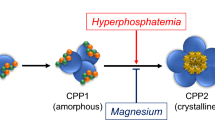Abstract
In this cross-sectional study, selenium (Se) levels in the sera of 35 hemodialysis (HD) patients and 34 patients undergoing continuous ambulatory peritoneal dialysis (CAPD) for more than 3 months were compared with the serum Se levels of 34 healthy volunteers. The observed Se levels of 100.8 ± 51.9 µg/L in the sera of the HD patients and of 65.5 ± 32.1 µg/L in the sera of the CAPD patients were significantly lower than the 134.9 ± 81.2 µg/L of the controls, with p = 0.002 and 0.02, respectively. Furthermore, the Se levels were significantly higher in the HD rather than the CAPD patients (p = 0.01). In the spent dialysate effluent fluid of 32 of the CAPD patients Se was undetectable, in the remaining two CAPD patients the Se levels were 1.9 and 4.6μg/l, respectively. The low Se levels of HD and CAPD patients as compared to healthy persons are attributed to diminished Se retention due to chronic oxidative stress.
Similar content being viewed by others
References
Olszewska M (2004) The effect of hemodialysis on some parameters of the antioxidant system in the blood of patients with chronic renal failure. Ann Acad Med Stetin 50(1):41–52
Yavuz O, Bicik Z, Cinar Y et al (2004) The effect of different dialysis membranes on oxidative stress and selenium status. Clinica Chimica Acta 346(2):153–160
Adamowicz A, Trafikowska U, Trafikowska A et al (2002) Effect of erythropoietin therapy and selenium supplementation on selected antioxidant parameters in blood of uremic patients on long-term hemodialysis. Med Sci Monit 8(3):202–205
Zagrodzki P, Bartoń H, Walas S et al (2007) Selenium status indices, laboratory data, and selected biochemical parameters in end-stage renal disease patients. Biol Trace Elem Res 116(1):29–41
Letavayova L, Vlˇckova V, Brozmanova J (2006) Selenium: from cancer prevention to DNA damage. Toxicology 227:1–14
Ravn-Haren G, Bugel S, Krath BN et al (2008) A short-term intervention trial with selenate, selenium-enriched yeast and selenium-enriched milk: effects on oxidative defence regulation. Br J Nutr 99:883–892
Milly K, Wit L, Diskin C et al (1992) Selenium in renal failure patients. Nephron 61:139–144
Zachara BA, Adamowicz A, Trafikowska U et al (2000) Decreased plasma glutathione peroxidase activity in uremic patients. Nephron 84:278–279
Zachara BA, Trafikowska U, Adamowicz A et al (2001) Selenium, glutathione peroxidase, and some other antioxidant parameters in blood of patients with chronic renal failure. J Trace Elements Med Biol 15:161–166
Chen B, Lamberts LV, Behets GJ et al (2009) Selenium, lead, and cadmium levels in renal failure patients in China. Biol Trace Elem Res 131(1):1–12
Nhien NV, Khan NC, Yabutani T et al (2008) Relationship of low serum selenium to anemia among primary school children living in rural Vietnam. J Nutr Sci Vitaminol 54(6):454–459
Bellinger FP, Raman AV, Reeves MA et al (2009) Regulation and function of selenoproteins in human disease. Biochem J 422(1):11–22
Bogye G, Tompos G, Alfthan G (2000) Selenium depletion in hemodialysis patients treated with polysulfone membranes. Nephron 84:119–123
Harrison I, Littlejohn D, Fell GS (1996) Distribution of selenium in human blood plasma and serum. Analyst 121:189–194
Plecko T, Rükgauer M, Kruse-Jarres JD (1998) Distribution of human plasma selenium and its role in the antioxidant system. Metal Ions Biol Med 5:385–389
Nichol C, Herdman J, Sattar N et al (1998) Changes in the concentrations of plasma selenium and selenoproteins after minor elective surgery: further evidence for a negative acute phase response? Clin Chem 44:1764–1766
Sataar N, Fell GS, Harrison I et al. (1996) Are the low concentrations of plasma Se observed in some severly ill patients due to the acute phase response to inflammation, injury and sepsis? In: Program and Abstract Book of the 6th International Symposium in Selenium in Biology and Medicine, Beijing, p 80
Dworkin B, Weseley S, Rosenthal WS et al (1987) Diminished blood selenium levels in renal failure patients on dialysis: correlations with nutritional status. Am J Med Sci 293(1):6–12
Apostolidis NS, Panoussopoulos DG, Stamou KM et al (2002) Selenium metabolism in patients on continuous ambulatory peritoneal dialysis. Perit Dial Int 22(3):400–404
Park T, Cho K, Park SH et al (2009) Taurine normalizes blood levels and urinary loss of selenium, chromium, and manganese in rats chronically consuming alcohol. Adv Exp Med Biol 643:407–414
Sriram K, Abraham G (2000) Loss of zinc and selenium does not occur through peritoneal dialysis. Nutrition 16(11–12):1047–1051
Acknowledgments
This study was funded by The Shiraz Nephro-Urology Research Center of Shiraz University of Medical.
Author information
Authors and Affiliations
Corresponding author
Rights and permissions
About this article
Cite this article
Pakfetrat, M., Malekmakan, L. & Hasheminasab, M. Diminished Selenium Levels in Hemodialysis and Continuous Ambulatory Peritoneal Dialysis Patients. Biol Trace Elem Res 137, 335–339 (2010). https://doi.org/10.1007/s12011-009-8588-2
Received:
Accepted:
Published:
Issue Date:
DOI: https://doi.org/10.1007/s12011-009-8588-2




